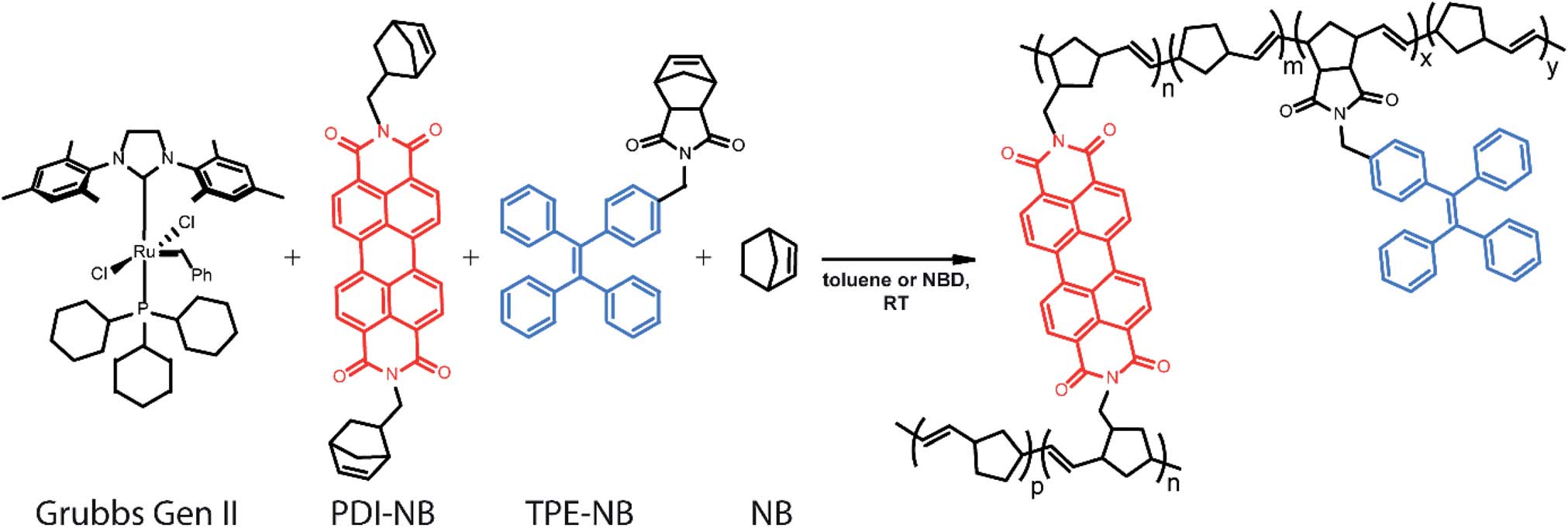If you are a polymer chemist, you may have dreamt of having a pair of eyes that can directly tell whether your polymerization reaction is working or not. Good news! Randall H. Goldsmith of the University of Wisconsin-Madison, U.S. and coworkers have developed an optical technique to monitor the course of a polymerization reaction in real-time. This breakthrough has been published in Chemical Science (DOI: 10.1039/C9SC05559B).
This technique relies on two parameters, fluorescence polarization anisotropy and aggregation-induced emission, to examine molecular weights. The authors specifically studied a well-controlled polymerization of norbornene (NB) into polynorbornene. Besides monomer, they added small amounts of two fluorescent probes, perylene diimide-functionalized norbornene (PDI-NB) and tetraphenylethylene-linked norbornene (TPE-NB), to the polymerization system. These NB derivatives were co-polymerized with NB (Fig.1).

Figure 1. Polymerization of norbornene (NB) catalyzed by a ruthenium-based Grubbs Generation II catalyst (Grubbs Gen II). PDI-NB and TPE-NB are two probes co-polymerized with NB to monitor the growth of polynorbornene.
The technique temporally resolved the evolution of polynorbornene molecular weight. The polymerization incorporated the probe molecules into the backbones of polynorbornene. As polymer chains grew, the rotational freedom of PDI-NB became increasingly limited, giving rise to an enhanced anisotropy signal during the first 200 min of polymerization (Fig. 2a, top panel and Fig. 2b, red curve). Further polymerization brought the incorporated TPE-NB together, triggering the aggregation-induced fluorescence emission of TPE-NB (Fig. 2a, bottom panel and Fig. 2b, blue curve). Importantly, the rise of the emission intensity from TPE-NB immediately followed the saturation of anisotropy signal from PDI-NB, making the two molecules complementary for monitoring the polymer growth in different time scales. Critically, the anisotropy signal intensity of PDI-NB correlated positively with the weight-average molecular weight of polynorbornene (Fig. 2c), demonstrating the capability of this technique to track the progression of polymer growth.

Figure 2. (a) (top) Color-scale images of anisotropy values of PDI-NB and (bottom) emission intensities of TPE-NB over time. Dots are top-view toluene microdroplets where polymerization happens. Scale bar: 250 µm. (b) Time-evolution of average anisotropy values of PDI-NB (red) and aggregation-induced-emission (AIE) intensity of TPE-NB (blue) throughout a polymerization. (c) The correlation between measured anisotropy values and the weight-average molecular weights of polynorbornene. The red dashed line provides a visualization of the trend.
The reported technique is applicable to other ring-opening metathesis polymerizations (ROMPs) involving monomers such as norbornadiene.
For expanded understanding, please read:
Optical Monitoring of Polymerizations in Droplets with High Temporal Dynamic Range
Andrew C. Cavell, Veronica K. Krasecki, Guoping Li, Abhishek Sharma, Hao Sun, Matthew P. Thompson, Christopher J. Forman, Si Yue Guo, Riley J. Hickman, Katherine A. Parrish, Alán Aspuru-Guzik, Leroy Cronin, Nathan C. Gianneschi, and Randall H. Goldsmith
Chem. Sci., 2020, 11, 2647-2656.
The blogger acknowledges Zac Croft at Virginia Tech, U.S., for his careful proofreading of this post.
About the blogger:
 Tianyu Liu obtained his Ph.D. (2017) in Chemistry from the University of California, Santa Cruz, in the United States. He is passionate about the communication of scientific endeavors to both the general public and other scientists with diverse research expertise to introduce cutting-edge research to broad audiences. He is a blog writer for Chem. Comm. and Chem. Sci. More information about him can be found at http://liutianyuresearch.weebly.com/.
Tianyu Liu obtained his Ph.D. (2017) in Chemistry from the University of California, Santa Cruz, in the United States. He is passionate about the communication of scientific endeavors to both the general public and other scientists with diverse research expertise to introduce cutting-edge research to broad audiences. He is a blog writer for Chem. Comm. and Chem. Sci. More information about him can be found at http://liutianyuresearch.weebly.com/.










